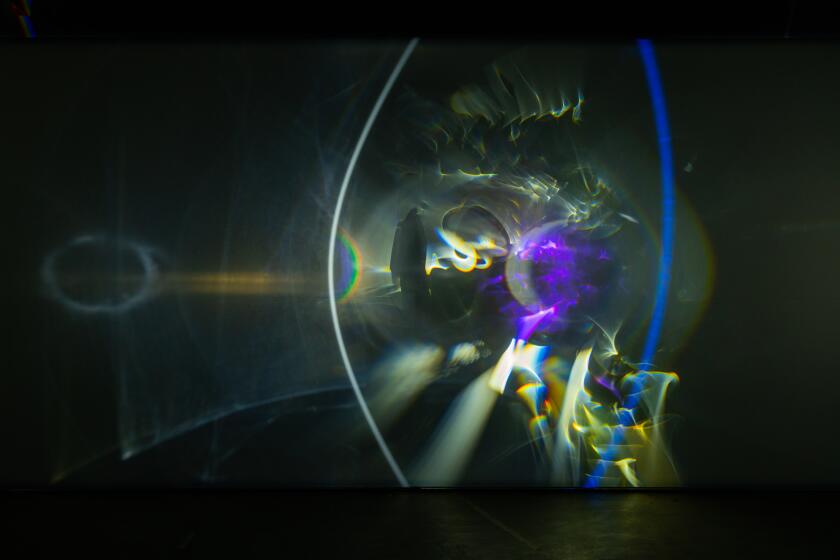The inaugural exhibition at American Post (1312...
The inaugural exhibition at American Post (1312 5th Ave.) features the paintings of Juliet Thompson, a student of Fernand Leger in the 1940s and now a resident of San Diego. All but a few of the paintings on view date from Thompson’s years in New York, several having been executed in Leger’s studio there.
Thompson assimilated Leger’s influence well, adopting his broad simplification of forms, use of tonal gradation to create a sense of volume and a similarly clear and vivid palette, while holding fast to her own, personalized imagery.
Her still-lifes combine concrete and symbolic objects in shallow, often gravity-free spaces, backed by rectangular areas of flat, intense color. Contrasts between a luminous gold and a pale blue-gray or a deep crimson animate the otherwise static spaces, rendering them vaguely theatrical.
Thompson’s subjects include objects of African, Mexican and Romanian origin (she published a book of her own text and photographs of Romania in 1939) that, combined with plants, flowers, clocks, notes and other small objects feel imbued with memory and private associations. A tricolor French flag and scrap of a French/English vocabulary list in “Broken English” (1943) suggest the artist’s attachment to France, cultivated through her connection to Leger and her own maintenance of a villa there. The modest and intimate quality of these arrangements gives them a charming, unpretentious appeal. Occasionally though, they lapse into an unbecoming sentimentality that robs them of their poignancy and renders them simply a clutter of souvenirs.
Music plays a prominent thematic role in many of the paintings, such as “Der Rosenkavalier” (1949), a monochromatic montage of a mask, gloved hand extending a flower, musical staff with notes and a designation of musical time. All of the elements are rendered with a concise sense of form and are interwoven tightly. Thompson’s best work is charged with vitality and spirit, its vibrant rhythms making the less successful appear doubly lackluster and lifeless.
The show continues through Jan. 10.
The Dietrich Jenny Gallery’s (664 9th Ave.) current group show, extended through Jan. 9, contains a stimulating array of work by both fresh and familiar names.
Kenneth Johnston’s cardboard and tape constructions and Steve Ilott’s paintings (slightly different from those in this show) were exhibited in the gallery’s previous, inaugural show, and many of the other artists included are scheduled for future one or two-person shows at the gallery. This presentation, then, functions as both a review and a preview of gallery fare.
Mathieu Gregoire’s three sculptural works are several steps removed from the functional objects they recall. His “Slot/Headboard” features two parallel, truncated forms emerging from a wall, one a worn and stained wooden headboard, the other a hollow, particle-board structure the same general shape as the headboard but translated into a more generic and geometric form. “Padded Corner Rail” suggests a functional object--a bar or railing--transformed into a non-functional design element, by its vertical placement in a corner. Gregoire’s “Nightstand,” though witty, is less provocative, but like all of the artist’s work, it stimulates a reconsideration of familiar forms.
Montreal artist Pierre Lamarche is represented by three mixed-media constructions of intimate scale and meaning. All three are made of weathered wood, roughly hewn into rectangular shapes, and bearing simple, naive illustrations.
“Manipulations Excessives” visualizes the notion of manipulation through variations on the children’s game of cat’s cradle and a patterned area reminiscent of a game board. The simple, folk-art quality of Lamarche’s constructions and his mix of obvious and elusive forms make his work engaging and touching.
A large, lush painting by Ernest Silva titled “Deer and Bridge” possesses a magnificent Japanesque elegance.
More to Read
The biggest entertainment stories
Get our big stories about Hollywood, film, television, music, arts, culture and more right in your inbox as soon as they publish.
You may occasionally receive promotional content from the Los Angeles Times.










